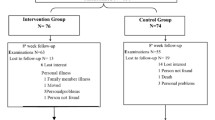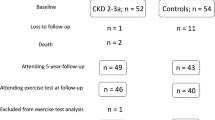Abstract
Purpose
Patients with chronic kidney disease (CKD) undergoing hemodialysis are generally physically inactive, have a high mortality rate due to cardiovascular disease (CVD), and may benefit from an exercise program to improve CKD-induced CVD causatives. Our purpose was to examine the effects of concurrent exercise training on CVD risk factors including peak oxygen uptake (\(\dot{V}{\text{O}}_{{2}} {\text{peak}}\)), C-reactive protein (CRP), asymmetric isomer of dimethylarginine (ADMA), fibroblast growth factor-23 (FGF-23), and glycated hemoglobin (HbA1c) in end-stage renal disease patients undergoing hemodialysis.
Methods
We performed a 12-week randomized controlled feasibility study examining the effects of a concurrent aerobic and resistance training on the aforementioned variables. Patients (age = 50.1 ± 14 years) randomized to either exercise training group (ET) (2 day/week of aerobic training with 40–60% \(\dot{V}{\text{O}}_{{2}} {\text{peak}}\) during dialysis; and 2 day/week of resistance training with rating of perceived exertion of 10–15 of 20 during rest), or untrained control group (CON).
Results
The employed exercise increased \(\dot{V}{\text{O}}_{{2}} {\text{peak}}\) (13.8%, p = 0.005) and decreased plasma levels of CRP (− 18.7%, p = 0.01), ADMA (− 9.1%, p = 0.01), FGF-23 (− 10.5%, p = 0.05), and HbA1c (− 7.9%, p = 0.01). Also, the change in \(\dot{V}{\text{O}}_{{2}} {\text{peak}}\) and HbA1c level in ET group was significantly greater than that of CON group (p = 0.04 and 0.05, respectively).
Conclusion
These findings provide compelling evidence that combined aerobic and resistance exercise could be considered as a potent stimulus to induce adaptations in aerobic capacity and decrease CVD risk factors in patients with chronic kidney disease.
Access this article
We’re sorry, something doesn't seem to be working properly.
Please try refreshing the page. If that doesn't work, please contact support so we can address the problem.


Similar content being viewed by others
Availability of data and materials
Original source data is available under reasonable request.
References
Afsar B, Siriopol D, Aslan G, Eren OC, Dagel T, Kilic U, Kanbay A, Burlacu A, Covic A, Kanbay M (2018) The impact of exercise on physical function, cardiovascular outcomes and quality of life in chronic kidney disease patients: a systematic review. Int Urol Nephrol 50(5):885–904. https://doi.org/10.1007/s11255-018-1790-4
Morishita S, Tsubaki A, Shirai N (2017) Physical function was related to mortality in patients with chronic kidney disease and dialysis. Hemodial Int 21(4):483–489. https://doi.org/10.1111/hdi.12564
Silva VROE, Belik FS, Hueb JC, Gonçalves RDS, Caramori JCT, Vogt BP, Barretti P, Bazan SGZ, Stefano GMMFD, Martin LC, Franco RJDS (2019) Aerobic exercise training and nontraditional cardiovascular risk factors in hemodialysis patients: results from a prospective randomized trial. Cardiorenal Med 9(6):391–399. https://doi.org/10.1159/000501589
Vallianou NG, Mitesh S, Gkogkou A, Geladari E (2019) Chronic kidney disease and cardiovascular disease: is there any relationship? Curr Cardiol Rev 15(1):55–63. https://doi.org/10.2174/1573403X14666180711124825
Perk J, De Backer G, Gohlke H et al (2012) European Guidelines on cardiovascular disease prevention in clinical practice (version 2012): The Fifth Joint Task Force of the European Society of Cardiology and Other Societies on Cardiovascular Disease Prevention in Clinical Practice (constituted by representatives of nine societies and by invited experts). Atherosclerosis 223(1):1–68. https://doi.org/10.1016/j.atherosclerosis.2012.05.007
Satoh M (2012) Endothelial dysfunction as an underlying pathophysiological condition of chronic kidney disease. Clin Exp Nephrol 16(4):1–4. https://doi.org/10.1007/s10157-012-0646-y
Fox CS, Muntner P, Chen AY, Alexander KP, Roe MT, Cannon CP et al (2010) Use of evidence-based therapies in short-term outcomes of ST-segment elevation myocardial infarction and non-ST-segment elevation myocardial infarction in patients with chronic kidney disease: a report from the National Cardiovascular Data Acute Coronary Treatment and Intervention Outcomes Network registry. Circulation 121:357e65
Jager A, van Hinsbergh VW, Kostense PJ et al (2002) C-reactive protein and soluble vascular cell adhesion molecule-1 are associated with elevated urinary albumin excretion but do not explain its link with cardiovascular risk. Arterioscler Thromb Vasc Biol 22:5938
Puschett JB, Agunanne E, Uddin MN (2010) Emerging role of the bufadi-enolides in cardiovascular and kidney diseases. Am J Kidney Dis 56:359–370
Gutierrez O, Isakova T, Rhee E (2005) Fibroblast growth factor-23 mitigates hyperphosphatemia but accentuates calcitriol deficiency in chronic kidney disease. J Am Soc Nephrol 16:2205–2215
Hernandez D, Espejo-Gil A, Bernal-Lopez MR et al (2013) Association of HbA1c and cardiovascular and renal disease in an adult Mediterranean population. BMC Nephrol 17(14):151. https://doi.org/10.1186/1471-2369-14-151
Shah SZA, Haram JA, Zeb A, Ullah R, Shah A, Ul Haq I, Ali I, Darain H, Chen H (2021) Movement is improvement: the therapeutic effects of exercise and general physical activity on glycemic control in patients with type 2 diabetes mellitus: a systematic review and meta-analysis of randomized controlled trials. Diabetes Ther 12(3):707–732. https://doi.org/10.1007/s13300-021-01005-1
Ulubay G, Akman B, Sezer S et al (2006) Factors affecting exercise capacity in renal transplantation candidates on continuous ambulatory peritoneal dialysis therapy. Transplant Proc 38:401–405. https://doi.org/10.1016/j.transproceed.2005.12.107
Kovesdy CP, Kalantar-Zadeh K (2009) Why is protein-energy wasting associated with mortality in chronic kidney disease? Semin Nephrol 29:3–14. https://doi.org/10.1016/j.semnephrol.2008.10.002
Matsuzawa R, Matsunaga A, Wang G et al (2014) Relationship between lower extremity muscle strength and allcause mortality in Japanese patients undergoing dialysis. Phys Ther 94:947–956. https://doi.org/10.2522/ptj.20130270
Isoyama N, Qureshi AR, Avesani CM et al (2014) Comparative associations of muscle mass and muscle strength with mortality in dialysis patients. Clin J Am Soc Nephrol 9:1720–1728. https://doi.org/10.2215/CJN.10261013
Huang M, Lv A, Wang J, Xu N, Ma G, Zhail Z, Zhang B, Gao J, Ni C (2019) Exercise training and outcomes in hemodialysis patients: systematic review and meta-analysis. Am J Nephrol 50(4):240–254. https://doi.org/10.1159/000502447
Uchiyama K, Adachi K, Muraoka K et al (2021) Home-based aerobic exercise and resistance training for severe chronic kidney disease: a randomized controlled trial. J Cachexia Sarcopenia Muscle 12(6):1789–1802. https://doi.org/10.1002/jcsm.12775
van Gersdorff G, von Korn P, Duvinage A et al (2021) Cluster randomized controlled trial on the effects of 12 months of combined exercise training during hemodialysis in patients with chronic kidney disease-study protocol of the Dialysis Training Therapy (DiaTT) trial. Methods Protoc 4(3):60. https://doi.org/10.3390/mps4030060
Evans ES, Battaglini CL, Groff DG, Hackney AC (2009) Aerobic exercise intensity in breast cancer patients: a preliminary investigation. Integr Cancer Ther 8(2):139–147. https://doi.org/10.1177/1534735409335506
Heyward VH, Gibson AL (2014) Assessing cardiorespiratory fitness. In: Heyward VH, Gibson AL (eds) Advanced fitness assessment and exercise prescription, 5th edn. Burgess Publishing, Minneapolis, pp 79–118
Matsuzawa R, Hoshi K, Yoneki K et al (2017) Exercise training in elderly people undergoing hemodialysis: a systematic review and meta-analysis. Kidney Int Rep 2(6):1096–1110. https://doi.org/10.1016/j.ekir.2017.06.008
Cheema B, Abas H, Smith B et al (2007) Progressive exercise for anabolism in kidney disease (PEAK): a randomized, controlled trial of resistance training during hemodialysis. J Am Soc Nephrol 18(5):1594–1601. https://doi.org/10.1681/ASN.2006121329
Pei G, Tang Y, Tan L, Tan J, Ge L, Qin W (2019) Aerobic exercise in adults with chronic kidney disease (CKD): a meta-analysis. Int Urol Nephrol 51(10):1787–1795. https://doi.org/10.1007/s11255-019-02234-x
Headley S, Germain M, Wood R, Joubert J, Milch C, Evans E, Poindexter A, Cornelius A, Brewer B, Pescatello L, Parker B (2014) Short-term aerobic exercise and vascular function in CKD stage 3: a randomized controlled trial. Am J Kidney Dis 64(2):222–229. https://doi.org/10.1053/j.ajkd.2014.02.022
Koufaki P, Mercer TH, Naish PF (2002) Effects of exercise training on aerobic and functional capacity of end-stage renal disease patients. Clin Physiol Funct Imaging 22(2):115–124. https://doi.org/10.1046/j.1365-2281.2002.00405.x
Sheykhlouvand M, Gharaat M, Khalili E, Agha-Alinejad H, Rahmaninia F, Arazi H (2018) Low-volume high-intensity interval versus continues endurance training: effects on hematological and cardiorespiratory system adaptations in professional Canoe Polo athletes. J Strength Cond Res 32(7):1852–1860. https://doi.org/10.1519/JSC.0000000000002112
Sheykhlouvand M, Khalili E, Gharaat M, Arazi H, Khalafi M, Tarverdizadeh B (2018) Practical model of low-volume paddling-based sprint interval training improves aerobic and anaerobic performances in professional female canoe polo athletes. J Strength Cond Res 32(8):2375–2382. https://doi.org/10.1519/JSC.0000000000002152
Sheykhlouvand M, Gharaat M, Khalili E, Agha-Alinejad H (2016) The effect of high-intensity interval training on ventilatory threshold and aerobic power in well-trained canoe polo athletes. Sci Sports 31(5):283–289. https://doi.org/10.1016/j.scispo.2016.02.007
Dungey M, Hull KL, Smith AC, Burton JO, Bishop N (2013) Inflammatory factors and exercise in chronic kidney disease. Int J Endocrinol. https://doi.org/10.1155/2013/569831
Wu L, Liu Y, Wu L, Yang J, Jiang T, Li M (2021) Effects of exercise on markers of inflammation and indicators of nutrition in patients with chronic kidney disease: a systematic review and meta-analysis. Int Urol Nephrol. https://doi.org/10.1007/s11255-021-02949-w
Liao MT, Liu WC, Lin FH, Huang CF, Chen SY, Liu CC, Lin SH, Lu KC, Wu CC (2016) Intradialytic aerobic cycling exercise alleviates inflammation and improves endothelial progenitor cell count and bone density in hemodialysis patients. Medicine (Baltimore) 95(27):e4134. https://doi.org/10.1097/MD.0000000000004134
Barcellos F, Del Vecchio FB, Reges A, Mielke G, Santos I, Umpierre D, Bohlke M, Hallal PC (2018) Exercise in patients with hypertension and chronic kidney disease: a randomized controlled trial. J Hum Hypertens 32(6):397–407. https://doi.org/10.1038/s41371-018-0055-0
Pawlak-Chaouch M, Boissière JJ, Munyaneza D, Tagougui S, Gamelin FX, Cuvelier G, Heyman E, Goossens JF, Descat A, Berthoin S, Aucouturier J (2019) Plasma asymmetric dimethylarginine concentrations are not related to differences in maximal oxygen uptake in endurance trained and untrained men. Exp Physiol 104(2):254–263. https://doi.org/10.1113/EP087398
Jayachandran I, Sundararajan S, Venkatesan S et al (2020) Asymmetric dimethylarginine (ADMA) accelerates renal cell fibrosis under high glucose condition through NOX4/ROS/ERK signaling pathway. Sci Rep 10:16005. https://doi.org/10.1038/s41598-020-72943-2
Paolocci N, Biondi R, Bettini M et al (2001) Oxygen radical-mediated reduction in basal and agonist-evoked NO release in isolated rat heart. J Mol Cell Cardiol 33(4):671–679. https://doi.org/10.1006/jmcc.2000.1334
Liu X, Xu X, Shang R, Chen Y (2018) Asymmetric dimethylarginine (ADMA) as an important risk factor for the increased cardiovascular diseases and heart failure in chronic kidney disease. Nitric Oxide 78:113–120. https://doi.org/10.1016/j.niox.2018.06.004
Ammar YM, Awad A (2020) Effect of a supervised peridialytic exercise program on serum asymmetri dimethylarginine in maintenance hemodialysis patients. Int J Nephrol 24:8878306. https://doi.org/10.1155/2020/8878306
Wolf M (2012) Update on fibroblast growth factor 23 in chronic kidney disease. Kidney Int 82(7):737–747. https://doi.org/10.1038/ki.2012.176
Fakhrpour R, Tayebi Khosroshahi H, Ebrahim K, Ahmadizad S, Abbasnejad M, Mesgari Abbasi M, Ghanbari A, Yaghoobi SF (2020) Effect of sixteen weeks combined training on FGF-23, Klotho, and Fetuin-A levels in patients on maintenance hemodialysis. Iran J Kidney Dis 14(3):212–218
Ikeda F, Doi Y, Ninomiya T, Hirakawa Y, Mukai N, Hata J, Shikata K, Yoshida D, Matsumoto T, Kitazono T, Kiyohara Y (2013) Haemoglobin A1c even within non-diabetic level is a predictor of cardiovascular disease in a general Japanese population: the Hisayama Study. Cardiovasc Diabetol 12:164. https://doi.org/10.1186/1475-2840-12-164
Abdelbasset WK, Tantawy SA, Kamel DM, Alqahtani BA, Elnegamy TE, Soliman GS, Ibrahim AA (2020) Effects of high-intensity interval and moderate-intensity continuous aerobic exercise on diabetic obese patients with nonalcoholic fatty liver disease: a comparative randomized controlled trial. Medicine (Baltimore) 99(10):e19471. https://doi.org/10.1097/MD.0000000000019471
Umpierre D, Ribeiro PAB, Kramer CK, Leitão CB, Zucatti ATN, Azevedo MJ, Gross JL, Ribeiro J, SchaanBD, (2011) Physical activity advice only or structured exercise training and association with HbA1c levels in type 2diabetes: a systematic review and meta-analysis. JAMA 305(17):1790–1799. https://doi.org/10.1001/jama.2011.576
Funding
No external financial support was received for this study.
Author information
Authors and Affiliations
Contributions
All authors contributed equally to this study.
Corresponding author
Ethics declarations
Conflict of interest
The authors declare that they have no conflict of interest.
Ethics approval
All procedures were in accordance with the ethical principles of the Declaration of Helsinki, approved by the ethical committee of the University of Guilan.
Informed consent
44 patients gave their written informed consent and volunteered to participate in the experiment.
Additional information
Publisher's Note
Springer Nature remains neutral with regard to jurisdictional claims in published maps and institutional affiliations.
Rights and permissions
About this article
Cite this article
Basir, S.S., Mirzaei, B. Effects of moderate-intensity concurrent exercise training on cardiovascular risk factors in patients with chronic kidney disease undergoing hemodialysis: a randomized control trial. Sport Sci Health 18, 1397–1404 (2022). https://doi.org/10.1007/s11332-022-00911-6
Received:
Accepted:
Published:
Issue Date:
DOI: https://doi.org/10.1007/s11332-022-00911-6




